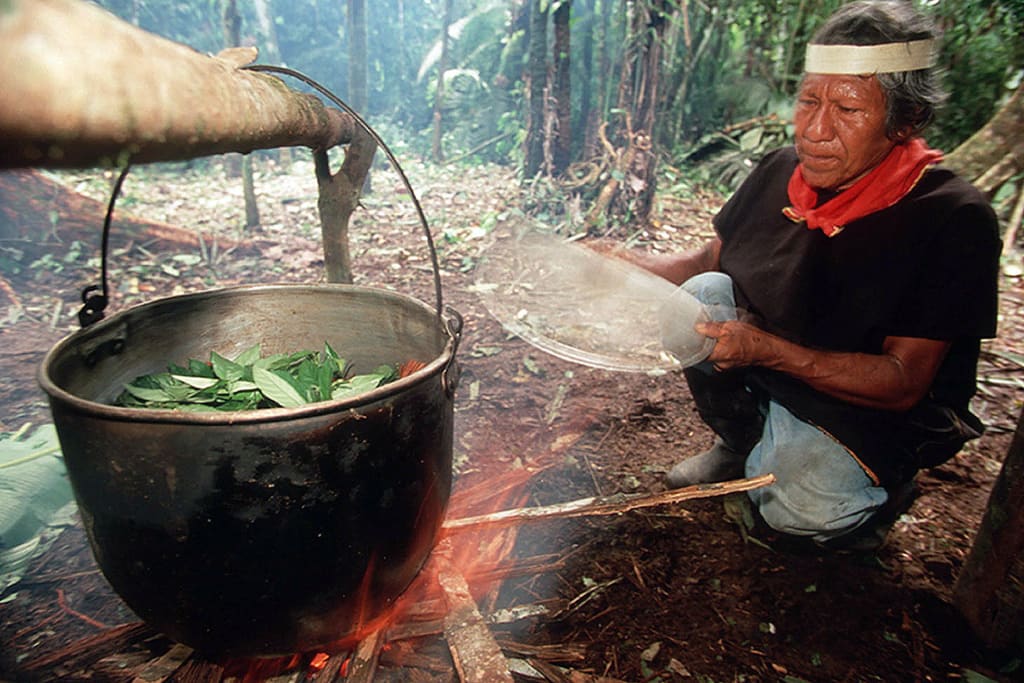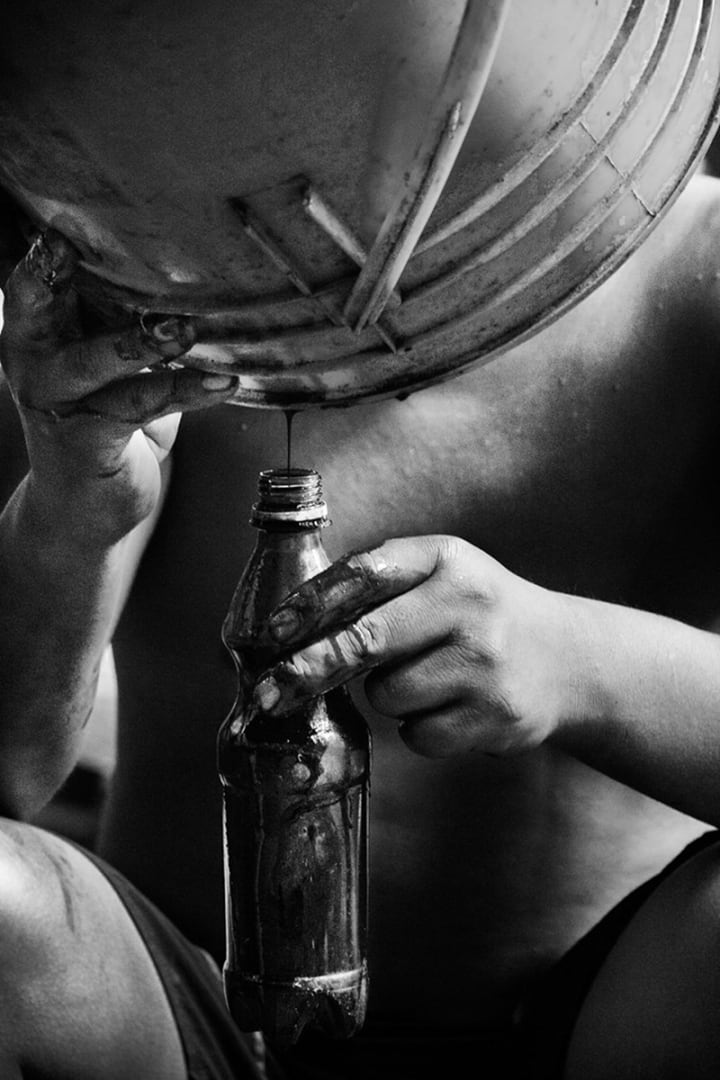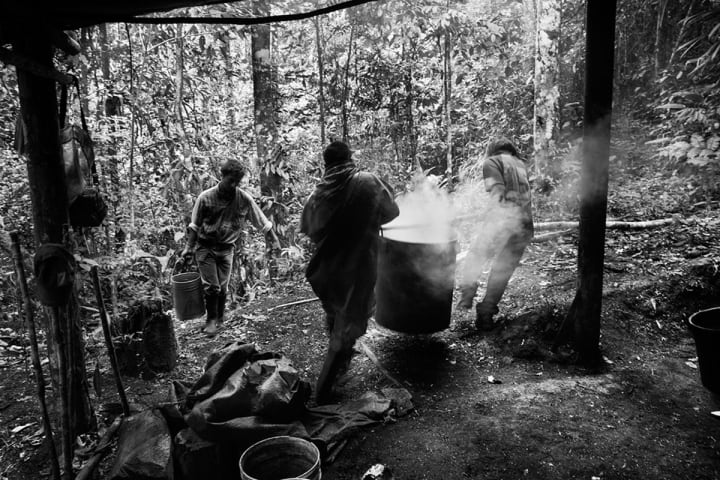What is Yage?
Folk healers and shamans administer Yage as a cure for psychic and physical ills.

An Amazonian Indian paddles a heavy canoe downriver, deep in the hold of South America. The Tunchis, spirits of the dead, call out to him in the medium of bird whistles from the jungle banks. Chullachi, a monster of unequal legs and horrible face, stalks the rain forest in search of victims. Beneath the canoe, in the murky depths, is Yacuruna—the Emperor of the waters and of the Indian dead. He is the devil of Amazonia, an amphibious creature who reigns from an underwater crystal palace. Yacuruna is ensconced in a tortoise Shell throne. He rests in a den of gazelle feathers, protected by a netting of butterfly wings woven by lightning bugs. His servants are a fleet of dolphins which change into human form so they can lure people to the kingdom of the river bed. Yacuruna, himself, often adopts the guise of a Christian spreading sin among the Indians.
Dolphins make crests near the bow of the overladen canoe. Will the paddler become their prey, or will he, like honored fishermen before him, capture one? If he catches a female he may take it for his bride. If not, he will at least make a love charm from its genital organs. Perhaps he will swim off with the dolphin into the depths of the river where Indians are said to walk about with their heads on backwards. Reports from various tribes indicate that many prefer the watery hell to the one they suffer in the beastly jungle.
Clearly, the Indian has a lot of the supernatural on his mind. When Yacuruna starts making mal pachos (whirlpools) in his path, he's got real problems. When Indians are confronted with such emotionally charged problems they take Yagé (YAH-HAY) for relief. Yagé is a hallucinogenic brew, derived from a woody vine native to the inner sanctums of the South American tropics. Folk healers and shamans administer it as a cure for psychic/ physical ills. Known as caapi in Brazil, ayahuasca in Peru and Ecuador, and Yagé in Colombia, the drug is believed to works its magic on epilepsy, jealousy and all kinds of psychic harm (collectively known as dano).
These herbal doctors believe that emotion is the root of all sickness and they guide their patients through psychtropic waves of hallucination so that they may, in vision, overcome themselves and their problems. Yagé is pharmaceutically similar to DMT structures. It produces a cosmic fervor which unleashes a wizard world of terrestial delusions. The Cashinahua Tribe of Peru has passed down the same set of ayahuasca visions, as they have their myths and lore, from generation to generation. These Indians see multicolored snakes, leaping jaguars of great proportions and ocelots of grand design in their visions. Their death is symbolized as a boa constrictor slowly crawling through its victim's open mouth. Eskimos, reputed to have taken the same dosage, have described giant cats of the cabin type variety since game cats haven't been seen in Artic regions since Peking Man.

While some tribes take Yagé for psychic relief, and while some take it for pleasure, others use it for more down-to-earth reasons-like war! The Jivaro of Eastern Ecuador drink it during the course of a pre-combat feast. This prepares him to kill a vicious foe and as he consumes his tonic he acquires, in trance, a soul invulnerable to physical harm. The Zaparo Indian, also of Ecuador, calls Yagé “the dead man's vine.” Zaparo medicine men will tip a gourd-full of the vision syrup when they settle difficult disputes, meet with representatives of other tribes, or seek to discover enemy plans.
The Omagua of Peru will drink between ceremonial dances in the course of an equatorial night. Battle follows in the morning after they have armed their spirits with Yagé. They have been described as pale ghosts as the drug sets in. Then, horror-struck before their fires, they ascend from their fears into assertive frenzy . . . seizing weapons and flailing arms, beating spears into the earth as they curse the opposing powers. Psyching up, hallucinogenically, is as traditional as warfare for this tribe. Who dares threaten a demon warrior, vipers in his eyes, spiders in his blood? He is an omnipotent death messenger, working on alchemical engines, with charmed barbs and vision on his side.
But Yagé isn't all savage and ancient. It has wandered, like workable legend, from the rain forest to some of the cities where it is used in modern faith healing practices. The Peruvian city of Iquitos, for example, has adopted the jungle's heritage of hallucinogenic public health. Modern psychiatry has not penetrated to those fringes of civilization that border on the haunting morass of the Amazon Valley. The doctors on duty in the Peruvian out-back are trained for organic, medical problem-solving. Folk healers are the ones consulted for mental problems. A competent healer will refer some patients to doctors if the problem is medical in origin, and he will reject some if he considers that Yagé is too strong for them. Sometimes there grows a jealousy between doctors and healers in such communities because the people tend to favor the healer's word. And while Yagé is legal to obtain, practicing medicine without a license is against the law, even in the jungle.
Some tribes take Yage for psychic relief, some for pleasure, while others use it for more down-to-earth reasons-like war
The healer is not an unsophisticated man. He is a man of herbs and suggestions. His patients include bankers and slum-dwellers. They are riddled with tension, depression, broken hearts and melodramatic dreams . . . various strains of supernatural jungle fever that have become urbanized. The healer has a group of them sit in a circle where they drink of “the dead man's vine.' The healer tells them of its strength, and asks them to hold it down in their stomachs. The group smoke cigarettes and struggle with their bodies as they talk among themselves about their lives. The healer is the last to drink. Things soon warm up. Small fires burn at the fingertips and the weight of the mind pulls its autonomic plug. Someone starts crying about his rotten childhood. Someone else starts hugging him. A woman's husband ran out on her. A man's cousin has brought ruin to his life. Everyone has a story and everyone needs to be reassured. The healer orchestrates the peer group support. It's Group Therapy, with all the hysterics in tact, leavened with the holy brew of Yagé! "It's medicine for the mama's boy, the anal retentive, the bisexual and the overdone father figure, claims one American group therapist who alleges that he dosed his patients during a marathon 3-day session. One suspects that clinical application might be difficult. The healers never use placebos.

Yagé's basic processing is relatively simple: cut vine with machete, shave off inner bark and place it in boiling water for several minutes, or just let it soak in a handful of water when on the road. It will brew into a greasy, rather vulgar, beverage. It may be bottled for storage, though fresh brew is superior. Various tribes spice it with organic mixers: Peruvians often add toé (datura suadleons), some highland tribes put chacurina (b. rusbyana) into the steamy kettles.
No one claims that Yagé tastes good. Richard Spruce, an English botanist who spent fifteen years during the middle of the nineteenth century observing the Brazilian Tukanoan tribes of the Uaupes, described it this way:
"I had gone with the full intention of experimenting the caapi myself, but I had scarcely dispatched one cup of the nauseous beverage, which is but half the dose, when the ruler of the feast came up with a woman bearing a large calabash of caxiri (mandioca beer), of which I must needs take a copious draught, and as I knew the mode of its preparation, it was gullped down with secret loathing. Scarcely had I accomplished this feat, when a large cigar two feet long and as thick as the wrist was put into my hand, and etiquette demanded that I take a few whiffs of it--I who had never smoked a cigar or pipe of tobacco. Above all this, I must drink a large cup of palm wine, and it will be readily understood that the effect of such a complex dose was a strong inclination to vomit . . .”
Many a herbal pioneer has come to South America in search of the Yagé way. William Burroughs came to the Putayamo region of Colombia and his journey led him to other magical encounters as well. He stretched his brainwaves in Aguardiente (raw sugar cane rum) stupors, and prepared for Yagé visions by whetting his cerebellum with gulps of Chicha (fermented corn maize). In the villages he passed through, women would blow mapacho smoke over their babies as night fell in order to keep evil spirits away. In order to pass more safely through the monte (uninhabited rain forest) he was introduced to Yora, a vine Indians use to prevent fatigue and overcome hunger. In a letter sent to the poet Allen Ginsberg, he wrote:
"In ten minutes I felt a tingling in my hands and a nice lift somewhat like benzedrine but not so tight. I walked the four hours back over jungle trail without stopping and could have walked twice that far.”
Ginsberg, intrigued by an oracle hidden in a vine, later went on his own Yagé expedition. Experimenting in the hut of a healer in Pucallpa, Peru he wrote:
". . . Lay down expecting God knows what other pleasant vision and then I began to get high-and then the whole fucking Cosmos broke loose around me, I think the strongest and worst I've ever had it nearly (I still reserve the Harlem experiences, being Natural, in abeyance. The LSD was Perfection but didn't get me so deep in nor so horribly in)— First II began to realize my worry about the mosquitoes or vomiting was silly as there was the great stake of life and Death-I felt faced by Death, my skull in my beard on pallet and porch rolling back and forth and settling finally as if in reproduction of the last physical move I make before settling into real death-got nauseous, rushed out and began vomiting, all covered with snakes, like a Snake Seraph, colored serpents in aureole all around my body, I felt like a snake vomiting out the universe . . .”
The power of the Yagé-taking culture depends upon an astral suspension to lift it above its jungle prison to a more desirous, if delirious, world. Spells like the Cochinada are created from the Offal of Vultures and rattlesnakes to effect death spells. Shinipampana, a love potion, is made from a small, odorless tuber which is chewed into a mash and then mixed with aromatics. Amazonians use it to capture their mates. They consult the Naipes (fortune-telling cards) for visions of their fate.
The ecstasies of such a culture carry its people to many lives and many worlds beyond the trap of the jungle. The only link between the many realities is the great river itself. It flows everywhere for the Indian. Its thrust breeds the many spirits of a land centuries behind and light-years ahead of the rest of this world. The Conquistadores never did discover the real treasure of the ethereal rain forest . . . the treasure that goes down with gulps of Yagé brew.
About the Creator
Frank White
New Yorker in his forties. His counsel is sought by many, offered to few. Traveled the world in search of answers, but found more questions.
Enjoyed the story? Support the Creator.
Subscribe for free to receive all their stories in your feed.






Comments
There are no comments for this story
Be the first to respond and start the conversation.